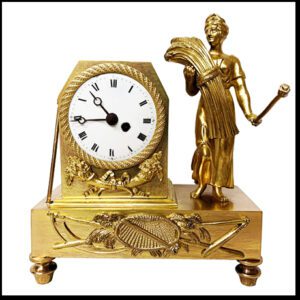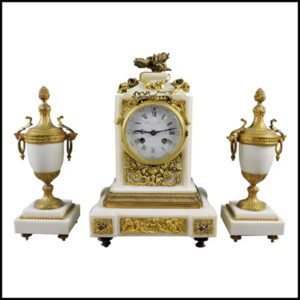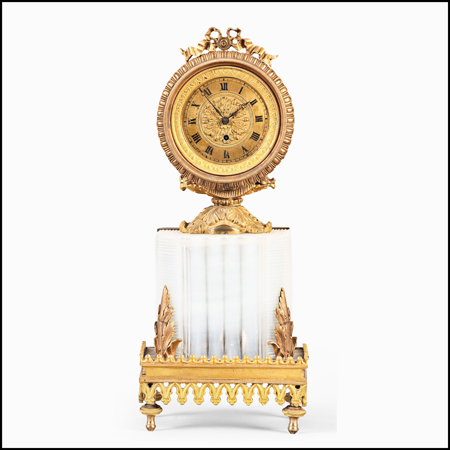Knowing the marketplace and the best types of antique clocks to purchase would be helpful when you consider buying an antique clock. You would need to navigate the myriad of antique clocks, dealers who sell them, what type of clocks have the best value as an investment, and how they fit in your home.
WHICH ANTIQUE CLOCK SALES OFFER ITEMS THAT BEST FIT YOUR HOME
Do you reside in a small apartment? If so, a shelf clock would be correct for you. A shelf clock is generally small and can fit virtually anywhere. A mantel clock could work with a spacious abode and an oversized mantel. If there is minimal space, you may consider a carriage clock, which is generally the smallest of all antique clocks. Old antique mantel clocks can also take time to set up and be cared for. Do you have both the time and patience, as it can be a labor of love, which may explain why some people are just content to have the beauty of an antique clock in their home when they stop running?
WHICH ANTIQUE MANTEL CLOCKS ARE WORTH BUYING
First of all, love what you buy. Buying anything, especially an antique clock, can be costly, but you must love it. After you go from loving it to realizing that you can have your “clock and investment,” too, take the time to choose wisely on all fronts. One motto I stand by is that I never buy at any antique clock sales if I cannot lift the old clock. “If I can’t lift it, I don’t want it.” 🙂
When I purchase an antique clock, I look at the clockmaker. Much of its value can come from who manufactured it. While the most prolific names in French clocks are Japy, Vincente, and Marti, they tended to make more clocks for the masses than the rich, who could afford the best French clocks of the time. This is not to say that these same clockmakers did not make some fine upper-end French clocks, as, for example, Vincenti made many of the clocks branded by Tiffany’s.

I prefer the top names when I purchase at antique clock sales, such as Raingo, Denier, Dubois, Leroy, or Bourret. All of these clockmakers are featured on our website. While they may cost more than a French clock from an unknown or lesser maker, they will hold their value as an investment far better. Examples of Ansonia clocks would be the Apex, Regal, or Utopia models of their American antique clocks.
If you are interested in buying an American antique clock, which, on the plus side, is easier to set up to run properly than French clocks, buy the upper-end models. They are more sought after and thus will better hold value.
THE SAFEST WAY TO PURCHASE AT ANTIQUE CLOCK SALES
Consider the condition of the mantelpiece clock or other antique clocks you can buy at the antique clock sales near you. Today, far more antique clocks are not in working order or have missing parts at auctions. As a reseller, with hopefully far more industry knowledge than the retail buyer, I buy many of mine from antique clock sales at auction. I have the expertise and many years of relationships of having any shelf clock or carriage clock that I buy from antique clock sales, and thus, I can assess whether the investment is worth it for the antique clocks that I purchase, but you may not.
If you are buying a mantel clock or shelf clock that requires repair, be aware of some of the costs you will incur. I just had an American antique clock re-gilded for $1500.00. Therefore, be confident that the gilding is mostly or as close to the original state as possible. If the clock requires a service, which consists of taking the clock apart, cleaning all of the surfaces, oiling the moving parts, and putting it back together, the cost to do so ranges from $350.00 to $650.00 and, in most cases, more as they usually need new bearings. Shipping and insurance are added, as many towns do not have expert repair persons, and you will need to ship your antique clock to them and have them return it to you.
Broken glass, if beveled, can be costly, and you will have a tough time finding a glass company with an expensive beveling machine locally. If the case is damaged, a bronze piece must be manufactured. Well, I can go on from there.
Another problem you may face when purchasing at antique clock sales is shipping. Like all else, shipping has gone up in our inflationary economy. Shipping of an old clock, once packed and weighing about 10-14 pounds, can vary. The same box can cost $150.00 or $400.00 depending on the city where the antique clock sales are held and who the company is. Ask the antique clock sales department to not only recommend shippers but also have them provide you with the dimensions and weight of the old clock so you can get bids in before purchasing an antique clock. An excellent source for antique clock repair is Boyds Clocks in Tampa, Florida. I use them.

I use these shipping guidelines from a seller at antique clock sales when requesting a quote so that the mantel clock can best weather the trip. They must never use Peanuts, as they cause “jiggle” and “jiggle” causes things to break, no matter how well packaged. I require “blue painter’s tape” as it is easy to remove, and it gets wrapped around any glass and overlaps the case. Glass will most times jiggle. Small bubbles when using bubble wrap are ok, but add some layers of large bubble wrap. The old clock will then go into a 300# “test weight” carton that will not crush easily. All are lined on all sides, top and bottom, with a one-inch foam core. If a heavy old clock has a statue atop and sits on a marble or other stone base, ship it on its side, marking the box with the side to be up, as stone cracks easily, especially if a heavy item is sitting on top of it. There usually are only four legs, so the center of the marble becomes the point of least resistance should the weight be bearing downwards.


